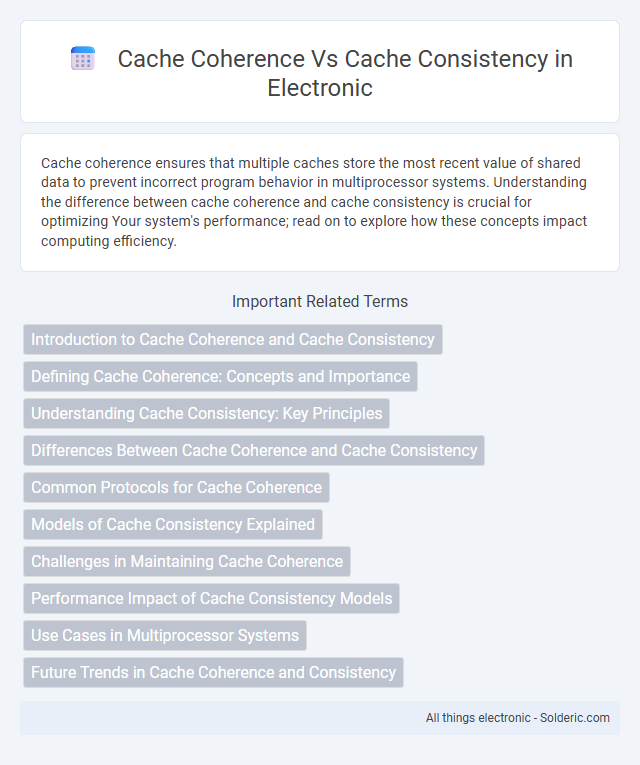Cache coherence ensures that multiple caches store the most recent value of shared data to prevent incorrect program behavior in multiprocessor systems. Understanding the difference between cache coherence and cache consistency is crucial for optimizing Your system's performance; read on to explore how these concepts impact computing efficiency.
Comparison Table
| Aspect | Cache Coherence | Cache Consistency |
|---|---|---|
| Definition | Ensures all caches have the most recent copy of a data block. | Ensures memory updates are seen in the same order by all processors. |
| Focus | Data state uniformity across caches. | Order and visibility of memory operations. |
| Problem Addressed | Prevents stale or conflicting data in multiple caches. | Prevents out-of-order memory updates causing inconsistent views. |
| Scope | Multiple cache copies of the same data block. | Global memory access order across processors. |
| Mechanism | Protocols like MESI, MOESI for invalidation or update. | Memory consistency models like Sequential Consistency, Weak Consistency. |
| Guarantee | Same data value in all caches after updates. | Same order of read and write operations across processors. |
| Example | All caches see the latest write to a shared variable. | All processors observe writes in the sequence they occurred. |
Introduction to Cache Coherence and Cache Consistency
Cache coherence ensures that multiple cache copies of the same memory location remain identical across different processors in a multiprocessor system, preventing stale or incorrect data usage. Cache consistency refers to the broader model that defines the rules and guarantees about the order and visibility of memory operations, ensuring a uniform view of memory. While cache coherence focuses on exact data replication, cache consistency governs the correct sequence and synchronization of memory accesses across caches.
Defining Cache Coherence: Concepts and Importance
Cache coherence ensures that multiple caches in a multiprocessor system maintain a uniform view of shared data by automatically updating or invalidating copies when changes occur. It prevents scenarios where processors operate on stale or inconsistent data, preserving system reliability and performance. Maintaining cache coherence is crucial for synchronization and correctness in parallel computing environments.
Understanding Cache Consistency: Key Principles
Cache consistency ensures that all caches in a multiprocessor system reflect the most recent write operations, preventing stale data reads and maintaining data synchronization across processors. Key principles include maintaining a single, unified view of memory and implementing protocols like MESI (Modified, Exclusive, Shared, Invalid) to manage data versions effectively. Your system's performance and correctness depend on adhering to these principles to avoid data conflicts and ensure reliable shared-memory operations.
Differences Between Cache Coherence and Cache Consistency
Cache coherence ensures that multiple cache copies of the same memory location remain identical across processors, preventing conflicts during parallel processing. Cache consistency regulates the order and timing of updates visible to all processors, focusing on the sequence of changes rather than data uniformity. Understanding these differences helps you optimize system performance by addressing either data uniformity or update sequencing in multiprocessor environments.
Common Protocols for Cache Coherence
Common protocols for cache coherence include MSI (Modified, Shared, Invalid), MESI (Modified, Exclusive, Shared, Invalid), and MOESI (Modified, Owner, Exclusive, Shared, Invalid), which manage data consistency across multiple caches in multiprocessor systems. These protocols ensure that when one cache updates a data block, other caches sharing that block are informed to maintain coherence. Understanding these protocols helps you optimize system performance by reducing stale data and ensuring reliable communication between cache layers.
Models of Cache Consistency Explained
Cache consistency models define rules ensuring uniformity of data across multiple cache memories in multiprocessor systems, preventing stale or incorrect data usage. Common models include write-invalidate and write-update protocols, which manage how changes propagate among caches to maintain consistency. These models differ in their strategies: write-invalidate invalidates other caches' copies upon a write, while write-update broadcasts the updated data, balancing overhead and data freshness.
Challenges in Maintaining Cache Coherence
Maintaining cache coherence involves addressing challenges such as ensuring all processors have the most recent data despite concurrent writes, managing increased traffic due to frequent invalidation or update messages, and handling race conditions that arise from simultaneous cache line modifications. The complexity intensifies with scalability as the number of cores grows, leading to higher latency and bandwidth consumption in coherence protocols like MESI or MOESI. Efficiently synchronizing cache states requires balancing performance overhead with consistency guarantees to prevent stale data and maintain system reliability.
Performance Impact of Cache Consistency Models
Cache consistency models directly affect system performance by determining how frequently caches synchronize their data with memory. Strict consistency models may reduce performance due to increased overhead in maintaining coherence, leading to higher latency and bus traffic. Your choice of cache consistency impacts scalability and throughput, balancing between data accuracy and efficient computational speed.
Use Cases in Multiprocessor Systems
Cache coherence ensures that multiple caches in a multiprocessor system maintain the most recent value of shared data, preventing stale data access and improving system reliability during parallel processing. Cache consistency, on the other hand, defines the order and timing of when updates become visible to processors, crucial for synchronization and correctness in applications requiring precise memory operation sequences. Your choice between these protocols impacts system performance and correctness in scenarios such as multi-threaded applications, database management, and real-time computing.
Future Trends in Cache Coherence and Consistency
Future trends in cache coherence and consistency emphasize scalability and efficiency for multicore and manycore processors through advanced protocols like directory-based and token coherence. Emerging techniques leverage machine learning algorithms to predict access patterns and dynamically optimize coherence traffic, reducing latency and power consumption. Hardware-software co-design approaches integrate coherence management into system software, enhancing consistency models for heterogeneous computing environments and distributed memory systems.
Cache coherence vs cache consistency Infographic

 solderic.com
solderic.com